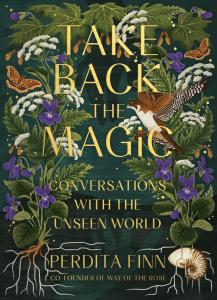Summoning the Ancestors: An Excerpt from Take Back the Magic by Perdita Finn
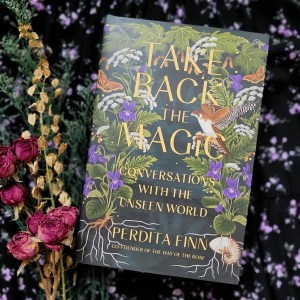
As fall approaches, we’re excited to think about ancestor work: remembering, honoring, and collaborating with those who came before us. Through a powerful combination of memoir, history, and a spirituality based in ecology, the forthcoming Take Back the Magic: Conversations with the Unseen World by spiritual teacher and co-founder of The Way of the Rose Perdita Finn teaches us the art and healing power of connecting with the dead.
Enjoy this exclusive excerpt featuring four summoning rituals you can use in your own ancestor work, courtesy of Take Back the Magic as we await its release on September 12th. Pre-order your copy at your favorite bookseller today. Plus! Be sure to upload your pre-order receipt here to gain access to Perdita’s exclusive virtual seminar “How to Grow a Miracle: A Special Opportunity to Chat with Perdita Finn about Ancestral Collaborations.”
Featured Post
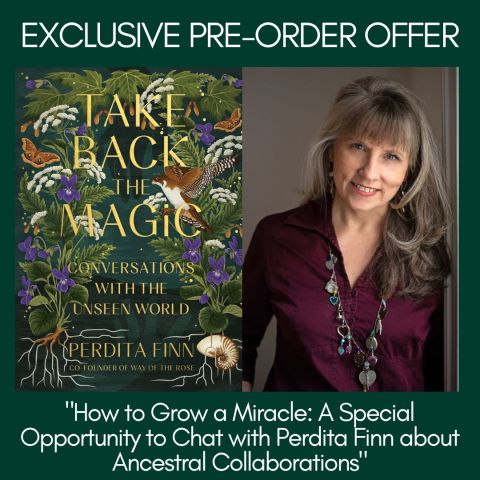
Summoning the Ancestors
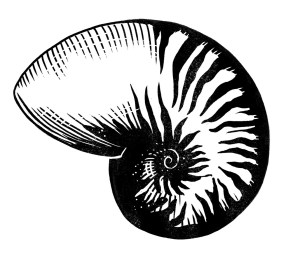
Ancestor Altars
Creating a space for the dead in our lives can be as simple as designating a small table in our homes for photographs of those who have passed on or as elaborate as building a designated ancestor altar with pictures, ritual objects, flowers, candles, and incense. Some people might want to craft a book filled with names and stories of departed loved ones that they can carry with them wherever they go. Still others might set a place at every meal for all the souls that are present. Every culture has traditions for acknowledging the presence of the dead among us and the dead themselves will guide us to what feels best for us and them.
What if I make a mistake and the souls of the departed I’m seeking don’t like it?
The dead, with the perspective of deep time and the long story, tend to be more forgiving than the living. They are just happy to be remembered. Rather than approaching this as an assignment we must master, let’s be like children sitting down with favorite toys, immersing ourselves in play and delight as we figure out what works for us. What feels easy and inviting? Welcoming the presence of ancestors into your life doesn’t have to be onerous or hard. In fact, it can be something you truly enjoy doing.
Can I include photos of the living on my altar to the dead?
We should always check in with ourselves. There are no rules, but our intuition will speak to us. If it makes us feel nervous and superstitious to include the living with the dead, we shouldn’t do it. If it makes us feel happy to see everyone gathered together, why not? Learning to trust the dead is much the same as learning to trust ourselves—indeed, in doing so we can expand our own senses and hear our deep internal wisdom.
What if I have no photos of the departed?
A woman in one of my classes used crystal skulls to represent various people from her past for whom she had no permanent record. Another I knew used feathers and stones. One man made a list of names, which he recited each night—and a few weeks later he received a box in the mail from a distant cousin filled with pictures of the long-gone relatives he had been summoning.
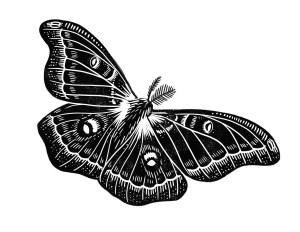
Litanies of the Departed
Names are powerful. We hear our name called out in a crowded room and turn to see who wants to get our attention. To know the name of a fairy-tale character is to be able to summon their power and magic. Most mantras and traditional prayers begin with the invocation of a name: Hail Mary. Om Namah Shivaya. Holy patroness in time of need, St. Rita. Hey you, Granny Nell. Many religious traditions include a practice of reciting the names of the patriarchs, the masters, or the important ones who have gone before us. A psychic friend I know loves to walk through old graveyards saying the names on the tombstones aloud—and connecting with the dead beneath the ground.
What if I don’t know the names of the dead?
We do the best we can, whether that is calling someone my great-grandmother’s grandmother or that old woman up the street with the black dog who gave me cookies as a child. I didn’t know the name of my father’s paternal grandmother but called on her as, “Papa’s Irish grandmother who died in childbirth in England.” One day my father sent me an original daguerreotype of her he had found in a box of old things—and on the back was her name: Catherine Harrington. Often the dead will find a way to tell us their names.
What if I leave someone out?
I try not to leave anyone out because I do not want to be left out. If I am always forgetting the name of someone who is close to me—an ex-husband or an old friend—I want to ask myself why and if there is some healing work that perhaps we need to do together.
What if I always remember the name of someone I never knew?
The land of the dead is filled with entangled mysteries. We may never understand them, but that doesn’t mean we can’t trust them. A man I know begins each day reciting the names of those who died of AIDS—even though he was born long after the initial crisis was over. He feels compelled to act on this devotion for reasons that have more to do with love than reason. A woman I know would always pray in the graveyard near her son’s dorm while he was in college and she was waiting for him to pack up his things. Years later she found herself still calling upon those same names for her child’s protection. By doing this work of connecting with those on the other side, we open ourselves to a more expansive view of the world—and who might have a place in ours. Who knows how many ways we are all connected to each other?
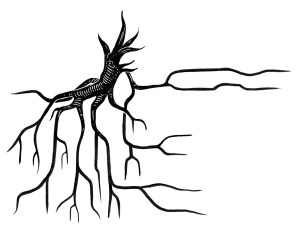
Sensory Invitations
The dead no longer have bodies—but they still remember their physical sensations. We can use our own sensory experiences to call upon them. Incense was originally invented as a way of summoning spirits from beyond the veil. Perhaps we want to light some on our ancestor altar or spritz a bit of a loved one’s favorite perfume, evoking with the smell an embodied memory. We bring fragrant flowers—roses, lilies, lilacs—to the graveyard for the same reason. The smell of tobacco and a whiff of good spirits are traditional ways of inviting the dead close. That’s why they are called spirits, after all! We might offer up favorite foods in a little bowl or even a little bit of each night’s meal to tempt the dead close. The only limit to what we do is our own imagination.
What do I do with the old food in the offering bowl?
Toss it outside or put it in the compost pile for other living creatures. Perhaps they, too, are our ancestors from lives we cannot remember or imagine.
Can I use gongs or bells or singing bowls?
Of course! Each of us has a repertoire of resources from our own experiences—and we should use whatever feels right and easy to us. Some of us may sing old nursery rhymes to the dead and others may sit down at the piano to play a sonata.
Do I need to do these rituals every day?
So many of us are worried about what we should be doing that we lose touch with what we actually want to do. If our gestures to the dead give us pleasure and joy, we will continue doing them—and that is what will make the dead happy.

Offering Prayers
What’s the difference between a spell and a prayer? Absolutely nothing. And who decides which words are sacred and which ones are not? For your own practice and your own purpose, the answer is you.
In truth, the dead remember the old prayers and love to hear these familiar sounds. Some people have found it very powerful to memorize a prayer of their ancestors in an old language and to recite it as an offering. We may find ourselves drawn for reasons we cannot explain to ancient devotional words. These words, like the names of the dead themselves, are summoning spells that draw the ancestors close and let them know we are welcoming their presence in our lives.
I don’t practice the religion of my ancestors—why should I say these old prayers?
Many of our ancestors departed their lives with these prayers on their lips, with these familiar words echoing in their hearts. They love to hear them again just as we are flooded with memories when an old song pops up on our playlist. It’s not a question of what they believed or what we believe, but whom we love and how. What if when someone was close to death, we asked them what prayer or hymn or mantra or song they would most like us to say in their honor after they were gone? That string of syllables will become like a thread moving back and forth across the veil, connecting us to each other. We can say words we don’t understand and unite our voices with the voices of our ancestral mothers and fathers. These prayers aren’t about aligning ourselves with piety and doctrine; they are about invoking the wisdom of the dead.
Dive Deeper
“Finn weaves a spellbinding meditation … an affecting ode to the power of the unseen.” —Publisher’s Weekly
What if you could live in a world where the guidance of those who were gone was available, right at your very fingertips? It’s possible, if we are open to it. Anyone can reclaim the forgotten guidance of the dead, and anyone can return to the realm of magic and miracles. In Take Back the Magic: Conversations with the Unseen World, author, spiritual teacher, and co-founder of The Way of the Rose Perdita Finn reveals that life is beginningless, love is endless, and those who have passed don’t truly go anywhere when they die. Weaving together memoir, history, and a non-denominational spirituality based in ecology, Finn invites readers to live the experience that the stories of our lives are much older, bigger, and more merciful than we have been led to believe.
Take Back the Magic takes the reader on a journey of healing, possibility, and love, as the story of how Finn healed her relationship with her bitter, patriarchal father long after his death unfolds over the course of thirteen moving chapters. Along the way, readers will learn how they, too, can reconnect with the generous guidance of the soul’s long story through deep time, recovering their lost relationships with their ancestors and the Earth itself. Throughout, Finn shares guidance, tips, and practical advice that will aid readers in forging their own relationships with those who have passed, as she invites every reader to reconnect with their own inner knowing and to call forth magic from the most ancient parts of humanity.
An inspiring invitation to healing in this life, and to experience that we are never alone, Take Back the Magic shows that the whole world is simply souls reaching out to and finding each other—and no one is ever truly lost to us, if we allow ourselves to begin our own conversations with the unseen world.





